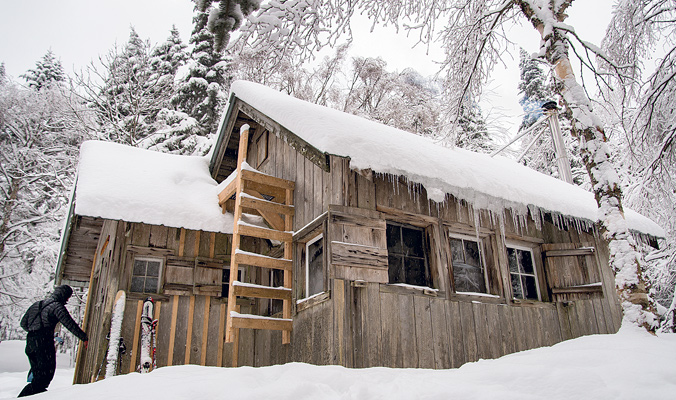In 2016, R.J. Thompson struck up a conversation with the then-executive director for Vermont’s Catamount Trail Association, Amy Kelsey. What started as a discussion about a potential yurt in Stowe, Vt.’s Nebraska Notch transformed into Kelsey connecting Thompson with Devon Littlefield, a Mainer-turned-Vermonter also curious about the lack of cohesive backcountry accommodations in the state. Fast forward two years and countless hours of research, coordinating with stakeholders and, yes, skiing, and Thompson and Littlefield currently run the Vermont Huts Association, a nonprofit working to unify existing trail networks via a statewide, four-season hut system. Here’s the story, as told by R.J. Thompson.

In the early 1930s, ski pioneer Edward Bryant built three cabins across his Bolton Valley property. Now, only Bryant Camp remains, refurbished in 2016 and available for skiers and riders to rent through the Green Mountain Club. [Photo] Sam Van Gerbig
We really went for it. All in. We got our board of directors assembled and we officially received our 501(c)(3) status in June of 2017. One of the first things we did was take an inventory of all existing huts and cabins across the state. We tried to do as good of a job as we could, knowing that we probably missed some here and there. The reality is, there wasn’t a hut association, because the [existing] huts are just not cohesive or connected in any way, shape or form.
After taking inventory, we started meeting with land managers, like the Green Mountain National Forest and Vermont Forest, Parks and Recreation, and we also enlisted feedback from Vermont Mountain Bike Association chapters between Stowe and Killington. We can look at a map and see where the Long Trail goes, where the Catamount Trail is, but we didn’t know where mountain biking trails would eventually connect—that just hasn’t happened yet.
So we started to conceptualize where our huts could be located, based on feedback from all of those entities, and where current backcountry ski zones are located or could be located, keeping in mind where these mountain biking trails may be developed.
We partnered with [Waitsfield, Vt.’s] Yestermorrow Design School to construct our first hut. I’d say it’s 95 percent finished. It’s on their campus right now, and once we have final approval, we’ll be transporting that this summer to its final destination on Forest Service land in Chittenden Brook Campsite. That will be our first official hut.
For me, personally, it feels like it’s taken forever, but I guess if I take a step back and look at the progression it is a quick turnaround. I could be getting ahead of myself, but it’s not unrealistic to think that by the end of 2019 we could have three of our own operational huts.
One of the challenges right now is that until we have a hut on the ground, we’re kind of just talking about a concept. Until we have proof of that concept, we’re just relying on members of the community to help get the word out. Once the first hut is open and guests can really experience that setting and understand what we’re going for, then we’ll be able to leverage that to gain a little more financial support and generate some of our own revenue.
If you’re in the nonprofit world, you might think at first, “Oh no, here’s another recreationally based nonprofit group; we’re all going to be competing for the same amount of money.” But it wasn’t like that. It’s more realizing that this hut network can really strengthen our trail networks and provide a new point of access to the outdoors and, hopefully, strengthen support across the board. I think that’s typical of being in Vermont—everyone is psyched and willing to help you out.
Our hut network will offer everything from basic self-service huts to a full-service hut that has a live-in caretaker with maybe one or two private rooms and a common bunkroom.
We want to be statewide, so at least end-to-end, meaning Canada to Massachusetts. We’re starting to think a little more east to west, too, as opposed to just north/south. I think it’d be great to have a hut network that could circumnavigate Camel’s Hump at some point, or maybe even Mansfield. We’d like to have those looped opportunities around the state as we traverse across the spine of the Green Mountains.
Part of our mission is to try to use recreation as a vehicle to bring a little more traffic into rural communities that could benefit from a boost in visitors spending dollars at their general stores or while grabbing a cup of coffee. We’ve all seen East Burke [home of Vermont’s Kingdom Trails mountain bike destination]. On a smaller scale we’ve seen Rochester with Brandon Gap, helping fuel that recreation economy. It’s not a silver bullet by any means, but any little bit helps in rural communities.
You can go to a hut network out west and have bigger terrain, certainly, but Vermont’s communities are tied so closely to their mountains that it’s a great opportunity for visitors to get a flavor of each community and the culture of each town when they pass through, whether on skis or bikes. The idea is to link the mountains to the towns via trails.










Related posts:
Grassroots Glades
How one trailbuilder is reshaping access to Vermont’s winter landscape
How to get the most out of gear
Community-Supported Skiing’s New Golden Era